Related Research Articles

Romanesque architecture is an architectural style of medieval Europe that was predominant from in the 11th and 12th centuries. The style eventually developed into the Gothic style with the shape of the arches providing a simple distinction: the Romanesque is characterized by semicircular arches, while the Gothic is marked by the pointed arches. The Romanesque emerged nearly simultaneously in multiple countries ; its examples can be found across the continent, making it the first pan-European architectural style since Imperial Roman architecture. Similarly to Gothic, the name of the style was transferred onto the contemporary Romanesque art.

Todi is a town and comune (municipality) of the province of Perugia in central Italy. It is perched on a tall two-crested hill overlooking the east bank of the river Tiber, commanding distant views in every direction. It was founded in antiquity by the Umbri, at the border with Etruria; the family of Roman Emperor Trajan came from Todi.

Trogir is a historic town and harbour on the Adriatic coast in Split-Dalmatia County, Croatia, with a population of 10,923 (2011) and a total municipal population of 13,192 (2011). The historic city of Trogir is situated on a small island between the Croatian mainland and the island of Čiovo. It lies 27 kilometres west of the city of Split.

Tourism in Croatia is a major industry of country's economy, accounting for almost 20% of Croatia's gross domestic product (GDP) as of 2021.
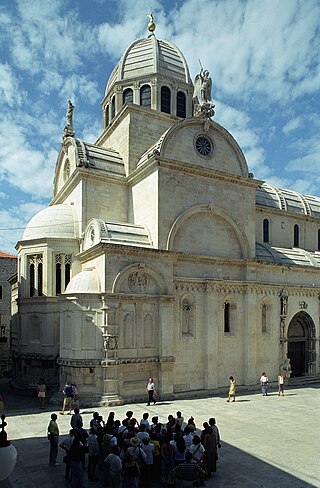
The Cathedral of St. James in Šibenik, Croatia, is a triple-nave Catholic basilica with three apses and a dome. It is the episcopal seat of the Šibenik diocese. It is also the most important architectural monument of the Renaissance in the entire country. Since 2000, the cathedral has been on the UNESCO World Heritage List.

Romanesque art is the art of Europe from approximately 1000 AD to the rise of the Gothic style in the 12th century, or later depending on region. The preceding period is known as the Pre-Romanesque period. The term was invented by 19th-century art historians, especially for Romanesque architecture, which retained many basic features of Roman architectural style – most notably round-headed arches, but also barrel vaults, apses, and acanthus-leaf decoration – but had also developed many very different characteristics. In Southern France, Spain, and Italy there was an architectural continuity with the Late Antique, but the Romanesque style was the first style to spread across the whole of Catholic Europe, from Sicily to Scandinavia. Romanesque art was also greatly influenced by Byzantine art, especially in painting, and by the anti-classical energy of the decoration of the Insular art of the British Isles. From these elements was forged a highly innovative and coherent style.
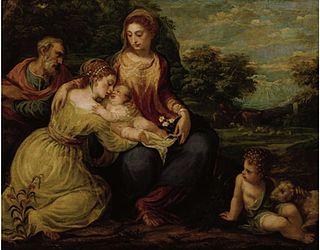
Andrea Meldolla, also known as Andrea Schiavone or Andrea Lo Schiavone was an Italian Renaissance painter and etcher, born in Dalmatia, in the Republic of Venice to parents from Emilia-Romagna, active mainly in the city of Venice. His style combined Mannerist elements, a relative rarity in Venice, with much influence from the mainstream of Venetian painting, especially Titian.

Ivan Rendić was a Croatian sculptor.

The architecture of Croatia has roots in a long history: the Croats have inhabited the area for fourteen centuries, but there are important remnants of earlier periods still preserved in the country.
Croatian art describes the visual arts in Croatia, and art by Croatian artists from prehistoric times to the present. In Early Middle Ages, Croatia was an important centre for art and architecture in south eastern Europe. There were many Croatian artists during the Medieval period, and the arts flourished during the Renaissance. Later styles in Croatia included Baroque and Rococo.
Andrea Alessi was a Venetian architect and sculptor, considered one of the most distinguished artists of Dalmatia.

The Cathedral of Saint Domnius, known locally as the Sveti Dujam or colloquially Sveti Duje, is the Catholic cathedral in Split, Croatia. The cathedral is the seat of the Archdiocese of Split-Makarska, headed by Archbishop Marin Barišić. The Cathedral of St. Domnius is a complex of a church, formed from an Imperial Roman mausoleum, with a bell tower; strictly the church is dedicated to the Virgin Mary, and the bell tower to Saint Domnius. Together they form the Cathedral of St. Domnius.

The Museum of Fine Arts, is an art museum in Split, Croatia containing works from the 14th century up to the present day providing an overview of the artistic developments in the local art scene. The museum was founded in 1931, and has a permanent exhibition of paintings and sculptures that includes works by major Croatian artists such as Vlaho Bukovac, Mato Celestin Medović, Branislav Dešković, Ivan Meštrović, Emanuel Vidović and Ignjat Job. The museum also has an extensive collection of icons, and holds special exhibits of works by contemporary artists.

Romanesque architecture is an architectural style of medieval Europe characterised by semi-circular arches. The term "Romanesque" is usually used for the period from the 10th to the 12th century with "Pre-Romanesque" and "First Romanesque" being applied to earlier buildings with Romanesque characteristics. Romanesque architecture can be found across the continent, diversified by regional materials and characteristics, but with an overall consistency that makes it the first pan-European architectural style since Imperial Roman Architecture. The Romanesque style in England is traditionally referred to as Norman architecture.

Co-cathedral of St. Mark the Evangelist is a baroque church and former cathedral in the Archdiocese of Split-Makarska. It is located in the center of the town of Makarska, Croatia, on Andrija Kačić Miošić Square.
Andrija is the South Slavic variant of Greek Andreas (Andrew). It may refer to:
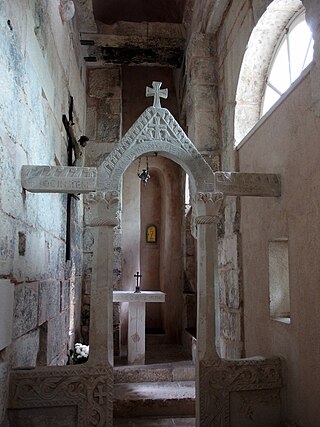
St. Martin's Church is a Roman Catholic church in Split, Croatia. Built into a small space within the ancient Golden Gate of Diocletian's northern wall, it is one of the oldest churches in the city. St. Martin's Church is one of Split's tourist attractions and is known for its fine 11th century chancel screen. It is currently in the care of the Dominican sisters, who have a monastery next door. The church itself is open to public visits.
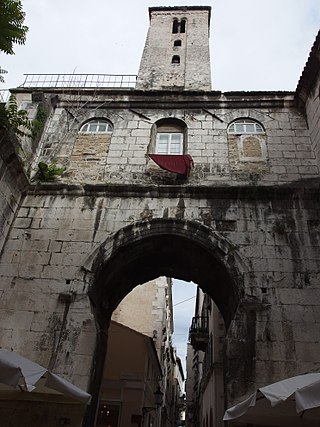
The Iron Gate, or "the Western Gate", is one of the four principal Roman gates into the stari grad of Split that was once Diocletian's Palace. Originally a military gate from which troops entered the complex, the gate is the only one to have remained in continuous use to the present day.

The Vestibule, also known as The Rotonda or The Atrium, is the first section of the imperial corridor in Diocletian's Palace that led from the Peristyle, which was once the formal entrance to the imperial apartments.
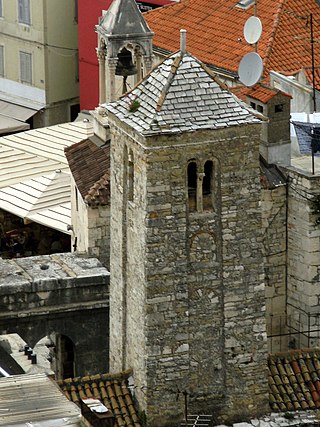
The Belltower of the Church of Our Lady of Zvonik is a disused Roman Catholic church in Split, Croatia. Built into a small space within the ancient Iron Gate of Diocletian's western wall. Today little survives of the building, apart from the belltower, one of the oldest in Croatia.
References
- 1 2 Thomas Graham Jackson (1887). Dalmatia, the Quarnero and Istria, with Cettigne in Montenegro and the Island of Grado. Clarendon Press. pp. 46–50. Retrieved 2012-09-10.
- 1 2 Kleinschmidt, Beda Julius (1912). . In Herbermann, Charles (ed.). Catholic Encyclopedia . Vol. 15. New York: Robert Appleton Company.
- 1 2 3 Fisković, Igor (1989). "Buvina, Andrija". Hrvatski biografski leksikon. Leksikografski zavod Miroslav Krleža. Retrieved 13 April 2015.
- ↑ Joško Belamarić (1997). Split: od carske palače do grada. Ministarstvo kulture Republike Hrvatske. ISBN 978-953-6158-05-8.